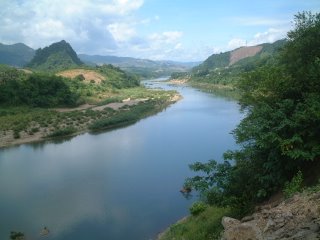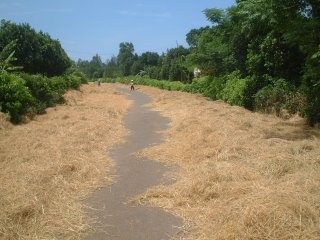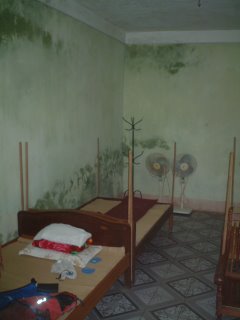On My Hue,,,,From Misery to Happiness










First, a couple of inspirational quotes to live by, at least for a bike tourist.
"To a nomad, the weight of his luggage is the price of his freedom."
"You can always make more money; you can never make more time."
Thanks to my friend and fellow world traveller Sean Cash for pointing out the first one!
I'm sitting in my guesthouse here in Hue, the old capital of Vietnam, replete with French toast and muesli and mango shakes, revelling in a couple of days of backpacker comfort. It's been a week since I last updated you, my faithful readers, on my whereabouts, so I will try to make it short but pithy.
I last wrote from the horrorshow called Sam Son Beach, a dreadful eyesore just outside Thanh Hoa. I was very glad to see Sam Son disappear behind me. I put in a long, dull day in the saddle, riding 147 km along flat, busy, ugly National Route 1A, Vietnam's answer to the Trans-Canada or Route 66,. It's a never-ending strip of motorcycle repair shops, restaurants, shops and people, with a fair amount of traffic, including buses that scream along at dangerous speeds, blowing their horns to scatter motorcyclists and bicycles from their juggernaut-like path. It was rice-harvesting time, and lots of folks were out in the fields, scything, carrying bundles of rice or driving oxcarts (or pushing adapted bicycles) groaning under huge loads of rice stalks. It was grey, humid weather, so not many photos, and I was glad to get off the road and head to another beach resort at the end of the day. The happiness lasted about 100 metres, when I realized that the last 8 km was going to be on the dustiest dirt road in Vietnam. Cua Lo Beach was cut from the same rotten cloth as Sam Son, but at least the water was cleann, Lots of "Moses boats": wicker baskets daubed with pitch and used for fishing.
The next day was also not too memorable, aside from the number of mentally ill tramps wandering the roads (at least 10, one of whom ran out to the road and took a swing at me). I met a couple of English teachers during the day, one of whom spoke pretty decent English. It seems that as I head south, a few more people actually speak a few words of English other than "Hello! Money!" The landscape became sandier, with coastal sand dunes protecting a marshy network of backwaters used for fishing, shrimp farming and, of course, growing rice. In the middle of the day, I came across the aftermath of a fatal accident; one of those runaway buses had run over two unfortunate motorcyclists; the motorcycle was trapped under the bus' front axle, but there were no signs of what could only have been the corpses of the riders. Huge pools of coagulated blood surrounded the hats and sandles of the motorcyclists, which were still lying in the road, nearly 100 metres before the bus. The bus must have hit them broadside while it was driving on the wrong side of the road, probably overtaking at high speed in the centre of town. After that memento mori, I have tried to be even more cautious than usual when in the vicinity of trucks and buses. At day's end, I found myself in a nowhere little town, staying in easily the most squalid accommodation of the trip, reminiscent of a Chinese truck stop. At least it was also the cheapest place I've stayed. I entertained an adult English class for a little while; their teacher had spotted me riding in. The students are going to work as construction workers in Dubai, and are trying to get a modicum of English before they leave. In Sam Son and especially in Cua Lo, I met a number of Vietnamese who had worked in Malaysia and picked up a smattering of English. Being just about the poorest country in ASEAN, I'm sure that Vietnam exports a lot of workers desperate to earn a bit more money than they do back on the farm.
The riding, and my mood, took a dramatic swing for the better the next day. It was a Three Swim Day (as opposed to a Three Dog Night). Route 1A finally swung close to the coast, and I kept passing deserted white-sand beaches getting pummelled by a pretty decent set of breakers. I stopped every once in a while for a swim, refreshing the body and soul beyond measure. It's so much easier to put up with heavy traffic and deafening air horns when you're still drying off from a dip in the surf. I also had a small pass to climb, at the mountainous border between the old French protectorates of Tonkin and Annam, and since it was Sunday, the traffic on the road was greatly reduced. I spent almost three hours off the bike at lunchtime, eating clams at a beachside restaurant, swimming and playing guitar. The day's 100 kilometres barely registered, and I slept in another beach hotel outside Dong Hoi and feasted on crab.
As I passed through Dong Hoi the next day, there were plenty of reminders that I was approaching the DMZ, the old border between North and South Vietnam and scene of some of the heaviest fighting and bombing of the war. Old French concrete pillboxes lined the beach road, and in Dong Hoi itself, a church blown to pieces by American bombs stands as a mute reminder of what the place was like 40 years ago. I rode through oppressive humidity towards the DMZ, and by lunchtime I had arrived at Vinh Moc, a troglodytic reminder of the human will to survive. Vinh Moc was a fishing and farming village just north of the DMZ that was destroyed by American bombing in 1966. Rather than flee north, the locals decided to stay put and live underground, rather like some Cappadocian villages in Turkey did during Arab invasions in the 7th century. They dug kilometres of tunnels to live and shelter in, and a network of trenches to get to and from their fields in safety. They somehow survived until the end of the war, despite fierce bombing and shelling from offshore battleships. What's now a fun day out for tour groups, wandering through a darkened subterranean labyrinth, must have been truly hellish at the time. I'm amazed that I encounter absolutely no anti-Western bitterness from the population of areas like that, many of whom must have lived through horrific experiences in the war.
The next day was time for one of the more quixotic excursions of the trip, a day-long dash to the old battlefield of Khe Sanh to give a short, solo concert. Carrying only my guitar and camera, I rode 66 km up into the mountains near the Lao border. I had forgotten how much easier it is to ride with no luggage, and I went like the wind, setting the fastest average speed of the trip despite the fact that it was a 500-metre climb to get to Khe Sanh. The battlefield, site of a major Marine Corps air base that was used to try to disrupt supplies moving along the Ho Chi Minh trail, is now in a peaceful, pretty setting, with drying black pepper from nearby plantations perfuming the air. The battlefield was deserted, so there was no audience as I sang three of my favourite war songs: "Letter from Bilbao" by Lowest of the Low, "The Band Played Waltzing Matilda" by someone whose name I have never been able to remember and, the inspiration for the whole idea, "Khe Sanh", the unofficial rock national anthem of Australia. Probably just as well that there was nobody around, as my voice sounded out of tune even to myself. The comment book in the museum was interesting; lots of US veterans had come to visit, and while most of their comments were thoughtful, there were a few along the lines of "America: home of the free, land of the brave. We won this battle!" which reminds me of the comment attributed to a vet visiting the DMZ. He said to an old North Vietnamese Army officer that the US had never lost a single battle during the entire war. "Entirely correct," was the reply, "but also irrelevant, isn't it?" There seems to be more bitterness among the US veterans than among the Vietnamese whose country was bombed into Swiss cheese. The ride back was through a biblical downpour that shorted out my cycling computer; it still hasn't come back to life three days later. Along the road I was passed by a hurtling truck; half an hour later, I came on another tragic tableau of the same truck stopped beside the mangled wreckage of a motorcycle.
The day before yesterday I rode through tremendous heat and humidity to get here to Hue. Along the noisy, dull road I ran into my first cycle tourist since I left the northern mountains. Charlie was an interesting guy, who had spent the last 4 years wandering the world on his bike. We exchanged stories and ideas for bike trips over a few cold sodas; he reckons that the Carreterra Austral in Chile was his favourite road, so I should get down there sometime to check it out. I skirted the massive 19th-century Citadel and entered the relative civilization of Hue. I always find that cities with history feel more civilized and less like chaotic, overgrown villages than do Johnny-come-lately urban sprawls. I found a great little hotel in the backpacker ghetto and set out to stuff myself with lots and lots of good food.
Yesterday I awoke tired and jaded (the beers I had the night before with Doug, a British backpacker, may have played a part) and lazed about all morning. In the afternoon I took my bike out to see a few sites. The Citadel, scene of the fiercest fighting in the 1968 Tet Offensive, is largely in atmospheric ruin, but there are a few restored or surviving structures to look at. As it's built in red brick, it reminds me a lot of Ayutthaya, its near contemporary capital of Thailand. Hue was only the capital for 100 years or so, but it remains an important cultural and religious centre. I rode out through fields already being prepared for the second rice crop of the year to an old wooden covered bridge, and then back into town to a lovely old pagoda and a series of Chinese temples. The pagoda was where the first Buddhist monk to burn himself to death in Saigon came from; his car is still on display. The photos of the event appeared in every newspaper in the world, along with the callous remarks of the Vietnamese First Lady: "It's a barbecue party. Let them burn themselves and we shall clap in delight." In true religious fashion, there's also a certificate that the monks heart was unaffected by the fire and is an official Sacred Heart Relic, good for miracles and prayers.
So now another day of touristing and dining well in Hue awaits. Today's project is the royal tombs lying outside the city. It's amazing how much touristing around the world goes on royal tombs: think of Xian, Beijing and the Egyptian Pyramids. I feel refreshed by having some culture to look at, rather than yet more concrete and uniformly ugly highway towns. My next stops should be Bach Ma National Park and then the old trading town of Hoi An, before the long push towards Saigon. I have racked up 2567 km so far, and the highway signs are telling me that Saigon is only 1060 km away, so I'm more than two thirds of the way through the trip, although only halfway through the time allotment. Lots more time for loafing on nice beaches ahead!
Peace and Tailwinds
Graydon

0 Comments:
Post a Comment
<< Home